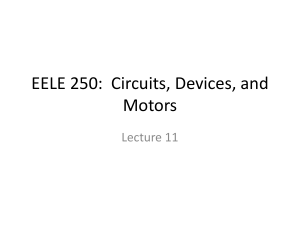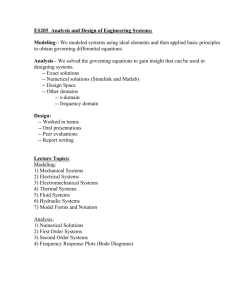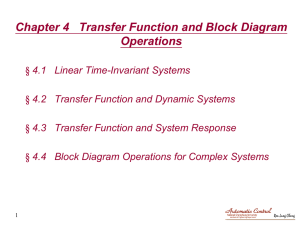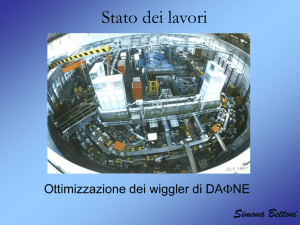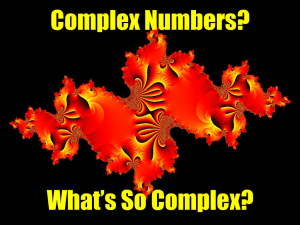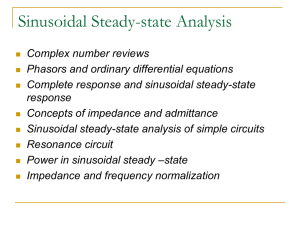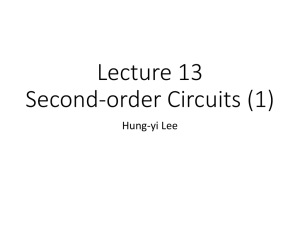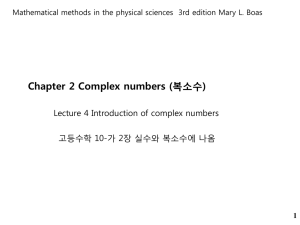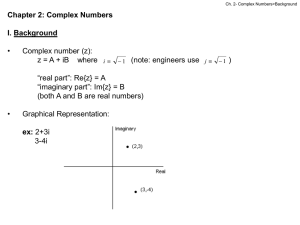Lecture 21
advertisement
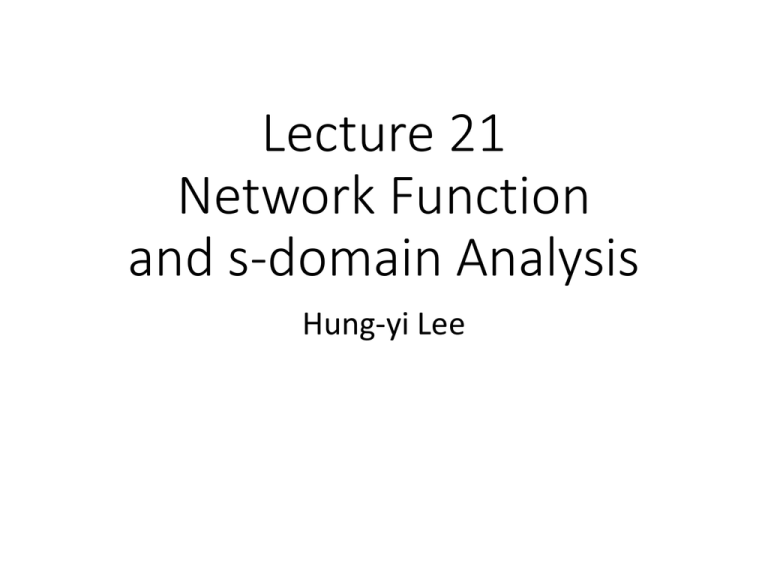
Lecture 21 Network Function and s-domain Analysis Hung-yi Lee Outline • Chapter 10 (Out of the scope) • Frequency (chapter 6) → Complex Frequency (sdomain) • Impedance (chapter 6) → Generalized Impedance • Network function What are we considering? Final target Chapter 6 and 7 Complete Response Chapter 5 and 9 What really observed Zero State Response Zero Input Response Forced Response Natural Response Steady State Response Transient Response x ( t ) A cos t What are we considering? Complete Response Final target Chapter 5 and 9 What really observed Zero State Response Zero Input Response Forced Response Natural Response Steady State Response Transient Response x ( t ) Ae t This lecture cos t Complex Frequency Complex Frequency In Chapter 6 Current or Voltage Sources x ( t ) A cos t Currents or Voltages in the circuit x ( t ) A cos t The same frequency Different magnitude and phase In Chapter 10 Current or Voltage Sources Currents or Voltages in the circuit x ( t ) Ae t cos t x ( t ) A e t cos t The same frequency and exponential term Different magnitude and phase You can observe the results from differential equation. Complex Frequency s plane x ( t ) Ae t cos t Phasor: X A Complex Frequency: s j Generalized Impedance Complex Frequency - Inductor For AC Analysis (Chapter 6) I L I m i i L ( t ) I m cos t i v L ( t ) L I m sin t i iL (t ) v L (t ) L I m cos t i 90 V L LI m i 90 Impedance of inductor v L (t ) L di L ( t ) dt ZL VL IL LI m i 90 Im i L 90 j L Complex Frequency - Inductor x (t ) Ae t iL (t ) I m e t cos t i cos t v L (t ) L I m e iL (t ) v L (t ) LIme t LIme t v L (t ) L di L ( t ) dt t cos t i L I m e 2 LIme t sin t i cos t i sin t i t 2 2 2 2 2 cos t i sin t i 2 2 cos t i tan 1 Complex Frequency - Inductor iL (t ) I m e t v L t L I m e cos t i I L I m i t V L LI m cos t i tan 2 1 2 2 2 i tan 1 Generalized Impedance of inductor ZL VL LI m i tan Im i 2 2 IL L 2 2 2 j 2 1 L 2 2 2 2 tan j L s L s j 1 Generalized Impedance • Generalized Impedance (Table 10.1) Element Impedance Generalized Impedance Resistor R R Inductor j L sL Capacitor 1 / j C 1 / sC Special case: s j The circuit analysis for DC circuits can be used. Example 10.2 L 1H, R 5 , C 1 s domain diagram V 20 90 V F 10 v ( t ) 20 e 2t 1 R Z ( s ) sL R // sL sC sCR 1 2 . 5 143 s 2 j4 cos( 4 t 90 ) V I V Z (s) i (t ) 8 e 20 90 2 . 5 143 2 t 8 53 cos( 4 t 53 ) A Network Function Network Function / Transfer Function • Given the phasors of two branch variables, the ratio of the two phasors is the network function/transfer function H s Y phasors of current or voltage X Complex number The ratio depends on complex frequency Y H s X X : input Y : output Network Function / Transfer Function • Network Function/Transfer Function is not new idea I Impedance: Z s V Admittance: Y s H s Y X V I 1 Z s I V Impedance and admittance are special cases for network function Network Function / Transfer Function H s Y Current or voltage X Current or voltage In general, network function can have four meaning H s V2 H s I2 Voltage Gain H s V H s I V1 I1 Current Gain I V “Impedance” “Admittance” Example 10.5 Vs IL VL VR sL R IC 1 VC sC H 1(s) IL 1 V s I L sL R sC Vs Polynomial of s H 1 s IL Vs 1 sL R 1 sC sC s LC sRC 1 2 Polynomial of s Example 10.5 Vs IL VL VR sL R IC 1 VC sC H 2 (s) VL Vs sL 1 sL R sC Polynomial of s 2 s LC s LC sRC 1 2 Polynomial of s Network Function / Transfer Function | Y | | H s || X | Y H s X |H(s)| is complex frequency dependent Y H s X 4 j7 s j s 0 represents dc H ( 0 ) is the dc gain Output will be very large when x ( t ) Ae 4 t cos 7 t Example 10.5 – Check your results by DC Gain Vs IL VL VR sL R IC 1 VC sC For DC H 1(s) H 2 (s) IL Vs VL Vs sC s LC sRC 1 2 2 s LC s LC sRC 1 2 H 1 0 0 Capacitor = open circuit H 2 0 0 Inductor = short circuit Example 10.5 – Check your results by Units IL Vs VL VR sL R IC VC 1 sC A C:F t L:H t V A V R : A 1 H 1(s) V t Vs A V sC H 2 (s) s LC sRC 1 2 2 1 V A t t t A V s:? A t V IL V 1V t A t A V V VL Vs 1 t 2 1 V A t t t A V 2 2 s LC s LC sRC 1 2 1 V A t t t A V 1V t A t A V Zeros/Poles Poles/Zeros • General form of network function H (s) bm s m b m 1 s a n s a n 1 s n m 1 n 1 b1 s b 0 a1 s a 0 The “zeros” is the root of N(s). If z is a zero, H(z) is zero. The “poles” is the root of D(s). If p is a pole, H(s) is infinite. N s D s Poles/Zeros • General form of network function b m s b m 1 s m 1 a n s a n 1 s n 1 m H (s) s m b m 1 s m 1 n b1 s bm bm bm an a n 1 a1 a0 n s n 1 an an K bm an s a1 s a 0 b0 bm s b1 s b 0 a1 K s z1 s z 2 s z m s p1 s p 2 s p n m zeros: z1, z2, … ,zm n poles: p1, p2, … ,pn Example 10.8 s 16 s 164 s 4 H (s) 5 s 32 s 3 2 s 16 s 164 s 3 Find its zeros and poles Denominator: s 32 p 1 32 2 s s s 16 s 164 2 36 s 40 s 400 2 Numerator: 4 2 s 0 s 0 s z 3 s z 4 z3 and z4 are the two roots of s2+16s+164 Zeros: z1=0, z2=0, z3=-8+j10, z4=-8-j10 s 36 p 2 , p 3 j 6 2 s 40 s 400 p 4 p 5 20 2 Poles: p1=-32, p2=j6, p3=-6j, p4=-20, p5=-20 Example 10.8 s 16 s 164 s 4 H (s) 5 s 32 s 3 2 2 36 s 40 s 400 2 Find its zeros and poles Zeros: Poles: z1=0, z2=0, p1=-32, p2=j6, p3=-6j, z3=-8+j10, z4=-8-j10 p4=-20, p5=-20 Pole and Zero Diagram Zero (O), pole (X) We can read the characteristics of the network function from this diagram For example, stability of network Stability • A network is stable when all of its poles fall within the left half of the s plane Y H s X If p = σp + jωp is a pole If the output is X Y Hp Y y t Ae 0 H(p)=∞ p cos p Complex frequency is p No input …… The waveforms corresponding to the complex frequencies of the poles can appear without input. Stability • A network is stable when all of its poles fall within the left half of the s plane The poles are at the right plane. Appear automatically Unstable The poles are at the left plane. Appear automatically Stable Stability • A network is stable when all of its poles fall within the left half of the s plane σp = 0 The poles are on the jω axis. Appear automatically Marginally stable oscillator Thank you! Acknowledgement • 感謝 趙祐毅(b02) • 在上課時指出投影片中的錯誤 Appendix What is Network/Transfer Function considered? Input Output Natural Response Forced Response Network Function H(s) Natural Response • It is also possible to observe natural response from network function. Y H s X Differential Equation Fix ω0, decrease α 2 2 1 , 2 0 The position of the two roots λ1 and λ2. α=0 Undamped Time-Domain Response of a System Versus Position of Poles (unstable) (constant magnitude Oscillation) (exponential decay) The location of the poles of a closed Loop system is shown. Cancellation Example 10.3 - Miller Effect Z in V in I1 V in V in V out 1 sC V in sC V in V out V in sC V in A V in 1 sC 1 A Capacitor with capacitance C(1+A) Example 10.3 - Miller Effect Z out V out I2 V out V out V in 1 V out sC sC V out V in A V in sC A V in V in A sC 1 A Capacitor with capacitance 1 1 sC 1 A 1 C 1 A Example 10.3 - Miller Effect
